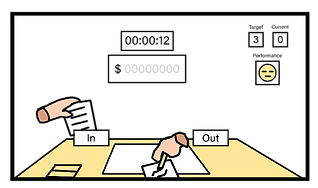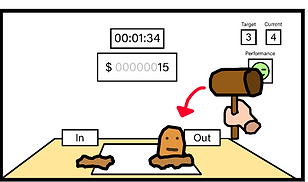
2024
4
Paperwork Eternal
/ overview
Paperwork Eternal is a VR comedy / arcade game about completing paperwork and being overwhelmed by distractions. It was my first virtual reality game that I made with a small team at QUT in 2024, including Zaden Bradshaw, Ethan Corcoran, and Ben Zhang.
Players must continuously complete the monotonous task of signing documents while a number of "day-dream" mini games distract the player. These range from simply playing whack-a-mole, to full on shootouts with cowboys. Overall we were pretty happy with what we accomplished in such a short time frame, and were lucky enough to show the game off at QUT's Immersive Games Fest and QUT's Open Day in 2024.
/ work
-
gameplay systems design
-
mechanics programming
-
level design
-
UI and UX
-
graphic design
-
documentation
-
project management
/ outcomes
Since Paperwork Eternal was my first attempt at a VR game, I learned a lot of important lessons while also producing a polished product I am overall very happy with. Some key take aways that I learned while working on it were the following:
-
Virtual-reality game development fundamentals.
-
Thorough documentation of games systems, levels etc.
-
Diegetic movement-based input systems and design.
-
Management of a project across a long period with a small team.
-
Iteration through repeated playtesting.
-
Marketing and presenting a game at various showcases.
/ details
Paperwork Eternal, as a VR game, needed to feature a lot of unique diegetic interactions to justify its platform, which were features that I had never worked on before. I wanted the game to have numerous of these specific movement controls (e.g. writing with a pencil, whacking moles, shooting targets) to really show what the medium is capable of, as well as providing an intuitive control scheme for players to immediately understand, even with little to no virtual reality experience.


Another consideration to make was the play area and the scale of the game environment, which both played huge roles in the initial design of the concept. I opted for the game to take place in a small cubicle, allowing players to both stand and sit, with little to no automatic movement required (e.g. teleporting, translating, etc.) due to the jankiness and motion sickness associated with those types of movement systems in some VR games.

Level Layout



Original Concept Storyboards

Because this was one of the first projects that comprised the entirety of it's corresponding unit at QUT, I had a lot more time to plan, document and playtest the different systems, mechanics and look and feel. Ultimately the game went through numerous different iterations, with a lot of work done on seamlessly guiding and providing consistent feedback for the player.
Due to the repeated support by QUT's game development staff, we were able to showcase the game at both QUT's Immersive Games Fest as well as the QUT Open Day. An important aspect of this experience was the marketing required as well as the interaction with players live as they provided feedback and described their experience.
